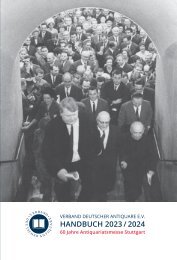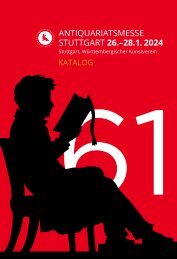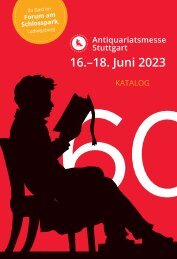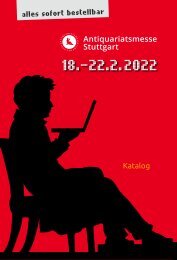Antiquariatsmesse Stuttgart 2021 - Katalog
Katalog zur Antiquariatsmesse Stuttgart 2021: Die Antiquariatsmesse Stuttgart als größtes Schaufenster für wertvolle Objekte des Antiquariats- und Graphikhandels in Deutschland findet in diesem Jahr in ungewohnter Form statt. Da eine Präsenzmesse nicht stattfinden kann, haben sich 76 Kollegen aus Deutschland, Großbritannien, Österreich, Frankreich, der Schweiz, den Niederlanden, den Vereinigten Staaten und aus Australien zusammengefunden, um einen Katalog für die Messe zu erstellen und gleichzeitig ein Angebot für eine virtuelle Messe zusammengetragen. Der Katalog wird am 7. Januar 2021 an interessierte Kunden verschickt, die virtuelle Messe öffnet ihre „digitalen Pforten“ am 29. Januar 2021 um 12.00 Uhr unter www.antiquariatsmesse-stuttgart.de
Katalog zur Antiquariatsmesse Stuttgart 2021: Die Antiquariatsmesse Stuttgart als größtes Schaufenster für wertvolle Objekte des Antiquariats- und Graphikhandels in Deutschland findet in diesem Jahr in ungewohnter Form statt. Da eine Präsenzmesse nicht stattfinden kann, haben sich 76 Kollegen aus Deutschland, Großbritannien, Österreich, Frankreich, der Schweiz, den Niederlanden, den Vereinigten Staaten und aus Australien zusammengefunden, um einen Katalog für die Messe zu erstellen und gleichzeitig ein Angebot für eine virtuelle Messe zusammengetragen.
Der Katalog wird am 7. Januar 2021 an interessierte Kunden verschickt, die virtuelle Messe öffnet ihre „digitalen Pforten“ am 29. Januar 2021 um 12.00 Uhr unter www.antiquariatsmesse-stuttgart.de
Erfolgreiche ePaper selbst erstellen
Machen Sie aus Ihren PDF Publikationen ein blätterbares Flipbook mit unserer einzigartigen Google optimierten e-Paper Software.
and numbered 1–52, preserved in a full vellum
box. € 13 750,–
Extremely rare complete pack of seventeenth-century
astronomical playing cards, intended as teaching aids.
The wonderful engraved figures are based on the images
in Johann Bayer’s Uranometria (1603), which was
the first accurate celestial atlas. The text accompanying
each image gives a brief description of the constellation,
and was intended to be memorised.- Siehe Abb. S. 172.
Beringer, David. Polyhdral Sundial. An early 18th
century German polyhedral sundial, with five
printed and coloured enamelled paper card dials,
one signed D. Beringer; the others decorated in
the Neo-Classical manner with floral sprays and
geometric borders, two faces depicting expectant
lovers, each face with brass gnomon, on wood pillar
with compass joint over the horizontal paper plate
and compass, the blued-steel needle with brass cap,
on four bun feet, 7 1/8 in (18,4 cm) high. € 2750,–
The top face of the cube has an engraved paper dial
printed with central garland and an hour scale in Roman
numerals clockwise from IIII to XII and I to VIII. Each
side, North, South, East, and West has a different hour
scale in Roman numerals, and different graphic designs,
including flowers and people. The North and South
faces are labelled Nord and Sud, each with hour scales
numbered in Roman numerals along with a central floral
garland decoration. The North side is also labeled
„D. Beringer“. The West dial displays a diagonal hour
scale flanked by cherubs with a garland. The East dial
has a similar design as the West.
Botanical Manuscript. A Very Early Botanical
Manuscript with 120 Fine Botanical Watercolours.
[Saxony 1618]. Folio (320 × 210 mm), contemporary
vellum, remains of silk ties, gilt lettered monograph
H. H. and date 1665 on upper cover, with 120 botanical
watercolours brightly painted in gouache on 117
leaves, contemporary Latin names on most leaves,
occasional offsetting. € 27 500,–
This is a very attractive and interesting early botanical
album, displaying exotics, perennials and garden flowers
in full bloom, when the majority of published works
were still concentrating on Herbs. – Seven leaves have
representations of tulips (fol. 40–44, 86, 94), at least six
others show American plants, including Ficus indica
major and Yucca gloriosa. The remaining plants are
mostly of European or Middle Eastern origin. – The
paper is the watermarked „Z“ or „Zittaw“ (thus obviously
Zittau) suggesting the origin of the manuscript is
the region of Saxony. – Exlibris Heinrich Göttig from
Flensburg (1786–1863). – Siehe Abbildung.
Gessner, Conrad. Icones Avium omnium, quae in
historia avium Conradi Gesneri describuntur …
Zurich, Conrad Froschauer, 1560. Folio (396 × 245
mm), I. pp. 137, 11, with contemporary hand
coloured woodcut printer’s device and a separate
handcoloured woodcut of a bird on title and 229
contemporary handcoloured woodcuts of birds, last
leaf with handcoloured woodcut portrait of Gesner;
II. pp. 127, [9], with contemporary handcoloured
printer’s device on title and 149 contemporary handcoloured
woodcuts; III. pp. [xxviii], 374, [2], with
737 contemporary handcoloured woodcuts; the first
few leaves with old creases and a few minor repairs
to marginal tears, a fine copy in contemporary calf,
both covers gilt with large centre- and corner gilt
cartouches, fleurons at corners, richly floral gilt
spine with gilt animal ornaments (spine rebacked
preserving original spine), gilt edges. € 95 000,–
A finely coloured set of the complete „Icones Animalium“,
which comprises the complete series of woodcuts
from Gesner’s „Historia Animalium“ (1551–1558),
along with some that appear in this edition for the first
time. This was the greatest zoological encyclopedia of
the sixteenth century and the greatest pictorial assembly
of zoological illustration of its time. The „Icones“
utilizes the entire assembly of woodcuts, but largely
eliminates the text, apart from the nomenclature.
Henisch, Georg. Commentarius in sphaeram procli
diadochi Cui adiunctus est Computus Ecclesiasticus,
cum Calendario triplici, & prognostico tempestatum
ex ortu & occasu stellarum. Augsburg,
David Franck, 1609, 4to, first edition, text of Proclus
in parallel Greek and Latin, title with woodcut
device, woodcut initials, 2 folding tables, errata f.
at end, contemporary French Olive Morocco, gilt,
arms of Charles de Valois, Duc d’Angoulême to
covers, and his CC monogram to spine. € 7000,–
Henisch’s great work on the sphere, astronomy and
exploration. Includes several mentions of America,
Columbus and Vespucci. – Hieronymus Wolf recommended
Henisch for the Protestant St. Anna Gymnasium
in Augsburg, where he was professor of logic
and mathematics from 1576–1617. He also taught in
Hebrew, Greek, Latin and rhetoric, held the office of
rector together with Simon Fabricius from 1580–93,
was head of the city library at the same time and led
a medical practice until his death. Four times he was
dean of the Augsburg medical college. He collected and
organized the files of the Collegium medicum founded
in 1582, thus laying the foundation for Augsburg’s rich
medical history.
Beautiful Rhine views – Janscha, Laurenz &
Ziegler, Johann. Collection de Cinquante Vues du
Rhin depuis Spire jusqu’à Dusseldorf Dessinees sur
les lieux d’apres Nature 1798. Fünfzig malerische
Ansichten des Rhein-Stromes von Speyer bis Düsseldorf
nach der Natur gezeichnet. Vienna, Artaria
& Co., 1798. Large Folio, (420 × 550 mm), attractive
binding of contemporary morocco backed decorative
boards, rebacked, with engraved title and 50
fine hand coloured etched and aquatint plates, text
in German and French. € 60 000,–
A magnificent series of finely hand-coloured views of
the Rhine, including the major cities, castles and sights
along the river at Speyer, Mannheim, Worms, Mainz,
Bingen, Koblenz, Bonn, Andernach, Godesberg, Poppelsdorf,
Cologne and Dusseldorf, and elsewhere.
174






